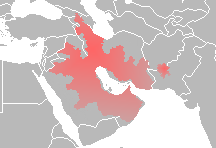Tanisi languages: Difference between revisions
Chrysophylax (talk | contribs) m (Text replacement - "Category:Conlangs" to "Category:Languages") |
(Removing duplicate arguments) |
||
| Line 40: | Line 40: | ||
==Genealogy== | ==Genealogy== | ||
{{clade | {{clade | ||
|label1=[[Proto-Tanisi]] | |label1=[[Proto-Tanisi]] | ||
|1={{clade | |1={{clade | ||
|label1=Tsani-Damian | |label1=Tsani-Damian | ||
|1={{clade | |1={{clade | ||
|1={{clade | |1={{clade | ||
|label1=Tsan | |label1=Tsan | ||
|label2=Manatho-Damian† | |label2=Manatho-Damian† | ||
|2={{clade | |2={{clade | ||
|label1=''Ancient Damian'' | |label1=''Ancient Damian'' | ||
|1={{clade | |1={{clade | ||
|1=''[[Damian]]'' | |1=''[[Damian]]'' | ||
}} | }} | ||
|2=''Manathi'' | |2=''Manathi'' | ||
}} | }} | ||
|1={{clade | |1={{clade | ||
|1={{clade | |1={{clade | ||
|label1=''Ancient Asaari'' | |label1=''Ancient Asaari'' | ||
|1={{clade | |1={{clade | ||
|1= '''Carolinian Asaari''' | |1= '''Carolinian Asaari''' | ||
|label2=''Middle Asaari'' | |label2=''Middle Asaari'' | ||
|2={{clade | |2={{clade | ||
|1='''[[Asaari]]''' | |1='''[[Asaari]]''' | ||
}} | }} | ||
}} | }} | ||
|2='''Virginian Asaari''' | |2='''Virginian Asaari''' | ||
}} | }} | ||
}} | }} | ||
}} | }} | ||
}} | }} | ||
|label2=Neumatic | |label2=Neumatic | ||
|2={{clade | |2={{clade | ||
|1=Namic | |1=Namic | ||
|1={{clade | |1={{clade | ||
|label1=Central | |label1=Central | ||
|1={{clade | |1={{clade | ||
|label1=''Ancient Namic'' | |label1=''Ancient Namic'' | ||
|1={{clade | |1={{clade | ||
|1= '''Rayan''' | |1= '''Rayan''' | ||
|label2 =''Middle Namic'' | |label2 =''Middle Namic'' | ||
|2={{clade | |2={{clade | ||
|1='''[[Namic]]''' | |1='''[[Namic]]''' | ||
}} | }} | ||
}} | }} | ||
}} | }} | ||
|label2=Southern | |label2=Southern | ||
|2={{clade | |2={{clade | ||
|1='''Tarisi''' | |1='''Tarisi''' | ||
|2='''Garathi''' | |2='''Garathi''' | ||
}} | }} | ||
}} | }} | ||
}} | }} | ||
}} | }} | ||
}} | }} | ||
*A language in '''bold''' denotes that it is extant. | *A language in '''bold''' denotes that it is extant. | ||
Latest revision as of 21:48, 26 June 2021
| Tanisi | |||||
|---|---|---|---|---|---|
| Tsani-Damian | |||||
| Created by | – | ||||
| Geographic distribution | North America | ||||
| Linguistic classification | language isolate
| ||||
| Proto-language | Proto-Tanisi | ||||
| Subdivisions | |||||
 Proportion of the Attamian ethnic groups that speaks an Tanisi language:
| |||||
Tanisi (/tənˈɪːsɪ/; also Tsani-Damian) is a North American language family which includes at least the Tsan languages, Damian, and Garathi languages.
In November 2012 a proposal connecting Asaari to the Neumatic languages of Western Utah into the Tanisi family was published and well received by a number of linguists.
General Information
The Tanisi languages is a family, or group, of constructed naturalistic languages, which share common features derived the hypothetic Proto-Tanisi language. They are inspired by a diversity of natural languages, each of them with a distinct style, yet with grammatical and semantical similarities, as well as a shared vocabulary.
These are the planned Tanisi languages so far:
- Asaari - My beloved blue little language. Tonal, American, agglutinative, voiceless and written in Vai. Yes. Vai. Didn't expect that, did you? Perhaps similar to Salishan languages, Navajo and the like.
- Damian - A so far sketchy language with Greek/Slavic/Shona/Khmer influences. Possibly ergative, maybe accusative. Mangled by allophony.
- Namic - Indo-European and especially Indo-Iranian influenced language, tripartite, heavy in phonemes, heavy in cases and heavy in scope. A language revised from being a mixed a priori - a posteriori language of the Indo-Iranian branch.
Attamian attributes
- A verb based morphology.
- Agglutinative by origin, decaded into fusional in Damian and Namic.
- An inherited tonal system - Tones in Asaari and Damian, pitch in Namic.
Genealogy
| Proto-Tanisi |
| |||||||||||||||||||||||||||||||||||||||||||||||||||||||||||||||||||||
- A language in bold denotes that it is extant.
- A language in italics denotes that it is now extinct (i.e. has no native speakers).
- † denotes the extinction of a linguistic subgroup